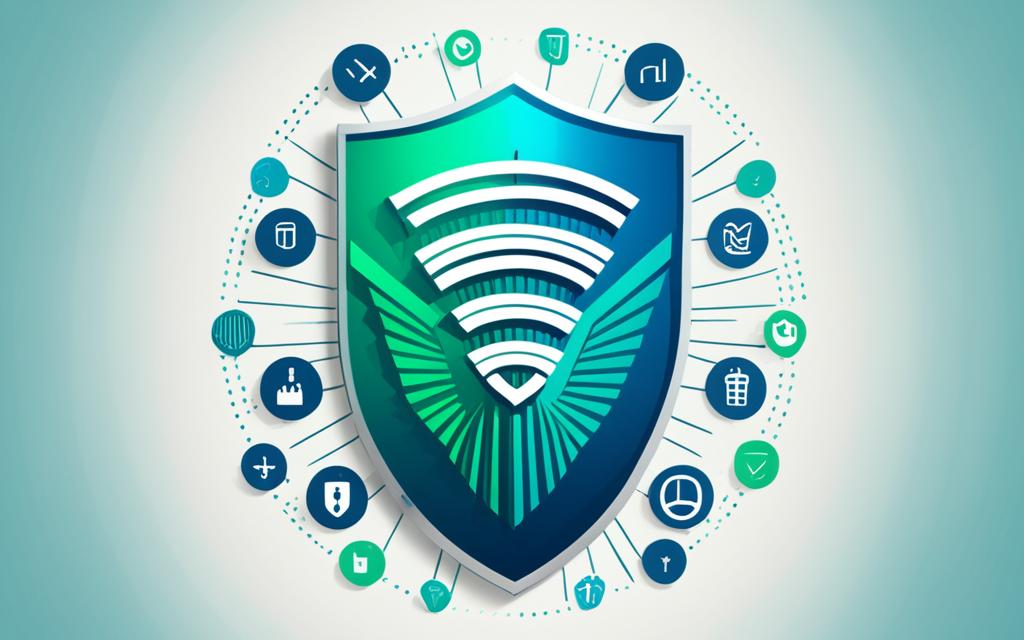Cellular networks have become an integral part of our connected world, but they also bring with them the risk of security threats. Unsecured wireless networks can be exploited by unauthorized users, leading to various risks such as piggybacking, wardriving, evil twin attacks, wireless sniffing, unauthorized computer access, shoulder surfing, and theft of mobile devices. To minimize these risks, it is crucial to implement security measures that include changing default passwords, restricting access, encrypting data, protecting the Service Set Identifier (SSID), installing firewalls, maintaining antivirus software, using file sharing cautiously, and keeping network devices updated.
Risks Associated with Network Infrastructure Devices
Network infrastructure devices, including routers, firewalls, switches, and servers, play a crucial role in facilitating communication within organizations. However, these devices also pose significant security risks, making them attractive targets for malicious cyber actors. Unlike desktops and servers, network infrastructure devices are often not maintained at the same security level, leaving them vulnerable to attacks.
There are various factors that contribute to the vulnerabilities of network devices. Exploitable services, default settings, lack of patching, and outdated equipment all increase the likelihood of unauthorized access and security breaches. To enhance the security of network infrastructure devices, organizations must implement proactive measures.
- Segment and segregate networks and functions: By dividing the network into smaller segments and separating critical functions, organizations can limit the impact of a potential breach and prevent lateral movement by attackers.
- Limit unnecessary lateral communications: Restricting lateral communication between different parts of the network reduces the attack surface and helps contain potential security threats.
- Harden network devices: Applying secure configurations and hardening measures to network devices, such as disabling unused services and implementing strong access controls, can significantly reduce vulnerabilities.
- Secure access to infrastructure devices: Using strong authentication methods, enforcing access controls, and regularly monitoring and auditing device access help prevent unauthorized individuals from compromising network infrastructure.
- Perform out-of-band network management: Separating network management traffic from regular network traffic minimizes the risk of unauthorized access and provides an additional layer of security.
- Validate the integrity of hardware and software: Regularly checking for firmware updates, conducting integrity checks, and verifying the authenticity of hardware and software components help identify and mitigate potential vulnerabilities.
Implementing these security measures is essential for protecting network infrastructure devices from unauthorized access and reducing the risk of security breaches. By taking a proactive approach to network security, organizations can maintain the integrity and confidentiality of their communication systems.
The Importance of Communications Security (COMSEC)
Communications security, also known as COMSEC, is an essential practice to prevent unauthorized access to telecommunications traffic and transmitted information. It encompasses various disciplines, including cryptographic security, emission security, physical security, and transmission security. In today’s digital communication landscape, where sensitive information is constantly at risk of being intercepted by hackers and malicious actors, COMSEC plays a crucial role in safeguarding the confidentiality, integrity, and availability of information.
To ensure effective communications security, it is essential to implement secure practices such as:
- Encryption: Encrypting sensitive data helps prevent unauthorized access and protects against data breaches. Encryption converts plain text into a non-readable format, making it inaccessible to unauthorized individuals. Implementing strong encryption algorithms and securing encryption keys are vital elements of COMSEC.
- Limited emissions: Limiting emissions reduces the risk of interception and unauthorized access to sensitive information. By controlling and minimizing electromagnetic emissions, organizations can enhance the security of their communications.
- Physical security: Ensuring physical security measures, such as access controls and surveillance, is crucial to prevent unauthorized access to network devices and systems. Physical security acts as a deterrent and helps protect against physical attacks and tampering.
- Protected transmissions: Protecting the transmission of information involves using secure protocols and technologies, such as Virtual Private Networks (VPNs) or Secure Sockets Layer/Transport Layer Security (SSL/TLS) protocols. These measures help safeguard data during transmission and prevent unauthorized interception.
The Role of COMSEC in Government and Private Sector Organizations
“Effective COMSEC practices are vital in safeguarding sensitive government communications and protecting corporate networks from unauthorized access and data breaches.”
Effective COMSEC practices are vital in safeguarding sensitive government communications and protecting corporate networks from unauthorized access and data breaches. Government organizations handle classified information and must adhere to strict COMSEC protocols to protect national security. In the private sector, businesses must also prioritize COMSEC to safeguard proprietary information, customer data, and intellectual property.
By implementing robust COMSEC measures, organizations can establish secure communication channels, maintain the confidentiality and integrity of information, and mitigate the risks associated with unauthorized access and encryption vulnerabilities. Combining technical solutions with comprehensive policies, training, and regular security audits ensures a holistic approach to communications security.

| Benefits of COMSEC | Challenges in Implementing COMSEC |
|---|---|
|
|
Implementing COMSEC Technologies
The implementation of COMSEC technologies involves several key aspects. One of the primary ways to protect communications is through encryption, which converts messages into indecipherable characters and requires a secure key for encoding and decoding. Encryption ensures that even if intercepted, the information remains inaccessible to unauthorized individuals.
Physical security measures are crucial to prevent unauthorized access to network devices and cryptographic systems. This includes implementing access controls and surveillance to monitor and restrict physical access to sensitive equipment and areas.
Additionally, the use of secure messaging protocols, such as Secure Sockets Layer (SSL) or Transport Layer Security (TLS), adds an extra layer of protection to communications. These protocols establish secure connections and ensure that data transmitted between parties remains encrypted and protected from eavesdropping.
Access protection and strong authentication methods, such as two-factor authentication and biometric authentication, further enhance the overall assurance of communications security. By implementing robust encryption key management practices, organizations can safeguard the integrity of cryptographic keys, ensuring that they remain confidential and are properly utilized.
To visually illustrate the implementation of COMSEC technologies, refer to the table below.
| COMSEC Technologies | Description |
|---|---|
| Encryption | Converts messages into indecipherable characters with secure key encoding and decoding. |
| Access Controls | Physical security measures to restrict unauthorized access to network devices and cryptographic systems. |
| Secure Messaging Protocols | Protocols like SSL or TLS establish secure connections to protect data transmission. |
| Access Protection | Protecting access to sensitive information using authentication methods like two-factor authentication. |
| Encryption Key Management | Robust practices to secure and manage cryptographic keys. |
Note: The implementation of COMSEC technologies requires a comprehensive and well-planned approach to ensure the protection of communications and sensitive information.
The Role of Cryptography in COMSEC
Cryptography plays a crucial role in ensuring the confidentiality and integrity of communications. By employing encryption algorithms, plaintext messages are transformed into ciphertext, rendering them unreadable to unauthorized individuals. The recipient, armed with the appropriate decryption key, can then reverse the process and access the original message.
Strong encryption algorithms and secure key management are fundamental elements of communications security (COMSEC) initiatives. These measures are integral to protecting sensitive information from unauthorized access and exploitation. Government and military organizations continually enhance and update their cryptographic systems to meet evolving security requirements.
To provide a clear visualization of cryptography’s importance in COMSEC, the table below outlines the key components and features:
| Component | Description |
|---|---|
| Encryption Algorithms | Convert plaintext messages to ciphertext using complex mathematical operations. |
| Decryption Key | Enables the recipient to decrypt ciphertext and restore it to plaintext. |
| Secure Key Management | Ensures the confidentiality and protection of encryption keys, preventing unauthorized access. |
By employing robust cryptographic methods and ensuring secure key management, organizations can safeguard their sensitive information and maintain the security and integrity of their communications.
Assuring Communications Security
When it comes to communications security, organizations must effectively manage various attributes to ensure the confidentiality and integrity of their communication channels. Physical security measures play a crucial role in preventing unauthorized access to network devices and systems. By implementing robust physical security protocols, organizations can minimize the risk of security breaches and protect their critical infrastructure.
“Secure communications protocols, such as SSL/TLS, and strong access controls are essential in preventing interception and unauthorized access to sensitive information.”
Secure communications protocols, such as SSL/TLS, offer an additional layer of protection by encrypting data during transmission, making it difficult for unauthorized individuals to intercept and access sensitive information. Combined with robust access controls, organizations can limit the risk of unauthorized access and protect their communication channels.
Encryption is a fundamental component of communications security, as it ensures that transmitted data remains confidential and protected. However, the effectiveness of encryption relies on proper encryption key management. Safeguarding encryption keys and ensuring their secure distribution, storage, and rotation is crucial to maintaining the confidentiality and integrity of communications.
By implementing these measures – physical security, secure communications protocols, and encryption key management – organizations can enhance the overall assurance of communications security. These practices help protect against unauthorized access, data breaches, and ensure the privacy of sensitive information.

In conclusion, ensuring communications security requires a holistic approach that addresses physical security, secure communications protocols, and proper encryption key management. By effectively implementing these measures, organizations can safeguard their communication channels and protect against potential security threats and unauthorized access.
Conclusion
Ensuring cellular network security is of utmost importance in today’s digital landscape. By implementing robust security measures, organizations can effectively safeguard communication channels and protect sensitive information from unauthorized access, data breaches, and exploitation.
One of the crucial steps in enhancing cellular network security is to change default passwords and implement strong authentication practices. This helps prevent unauthorized individuals from gaining access to network devices and systems, reducing the risk of potential security breaches.
Encrypting data is another vital measure to protect the confidentiality and integrity of communications. By utilizing encryption algorithms and secure key management, organizations can ensure that sensitive information remains unreadable to unauthorized individuals, mitigating the risk of interception and unauthorized access.
Furthermore, organizations should adhere to the principles of Communications Security (COMSEC) to mitigate the risks associated with cellular networks. This includes limiting emissions, securing transmissions, and implementing physical security measures, reinforcing overall communication security.
In conclusion, cellular network security demands a proactive approach that involves implementing communication security measures such as changing default passwords, encrypting data, securing access to infrastructure devices, and practicing COMSEC principles. By staying informed about the latest security technologies and best practices, organizations can maintain robust communication channels and protect sensitive information in the ever-evolving digital landscape.
FAQ
What are the risks associated with wireless networks in cellular networks?
The risks of unsecured wireless networks include piggybacking, wardriving, evil twin attacks, wireless sniffing, unauthorized computer access, shoulder surfing, and theft of mobile devices.
How can organizations minimize the risks associated with wireless networks?
Organizations can minimize risks by implementing security measures such as changing default passwords, restricting access, encrypting data, protecting the Service Set Identifier (SSID), installing firewalls, maintaining antivirus software, using file sharing cautiously, and keeping network devices updated.
What are the vulnerabilities of network infrastructure devices?
Network infrastructure devices such as routers, firewalls, switches, and servers are often easy targets for malicious cyber actors due to exploitable services, default settings, lack of patching, and outdated equipment.
How can organizations improve the security of network infrastructure devices?
Organizations can improve the security of network infrastructure devices by segmenting and segregating networks and functions, limiting unnecessary lateral communications, hardening network devices, securing access to infrastructure devices, performing out-of-band network management, and validating the integrity of hardware and software.
What is communications security (COMSEC)?
Communications security, also known as COMSEC, is the practice of preventing unauthorized access to telecommunications traffic or transmitted information through various disciplines, including cryptographic security, emission security, physical security, and transmission security.
How does COMSEC safeguard information?
COMSEC safeguards information by implementing secure practices such as encryption, limiting emissions, ensuring physical security, and protecting transmissions.
How does cryptography ensure the confidentiality and integrity of communications?
Cryptography uses encryption algorithms to convert plaintext messages into ciphertext, making them unreadable to unauthorized individuals. With the correct encryption key, the recipient can decrypt the ciphertext back into its original form.
What attributes need to be managed to ensure communications security?
To ensure communications security, organizations must manage physical security measures, implement secure communications protocols, control access, and properly manage encryption keys.
What is the role of cryptography in communications security?
Cryptography plays a vital role in ensuring the confidentiality and integrity of communications by converting messages into indecipherable characters using encryption algorithms. Strong encryption algorithms and secure key management are crucial components of communications security.
How can organizations assure communications security?
Organizations can assure communications security by implementing physical security measures, using secure communications protocols, controlling access, and properly managing encryption keys.
What security measures should organizations implement in cellular networks?
Organizations should implement security measures such as changing default passwords, encrypting data, securing access to infrastructure devices, and practicing COMSEC principles to safeguard communication and protect sensitive information in cellular networks.



















